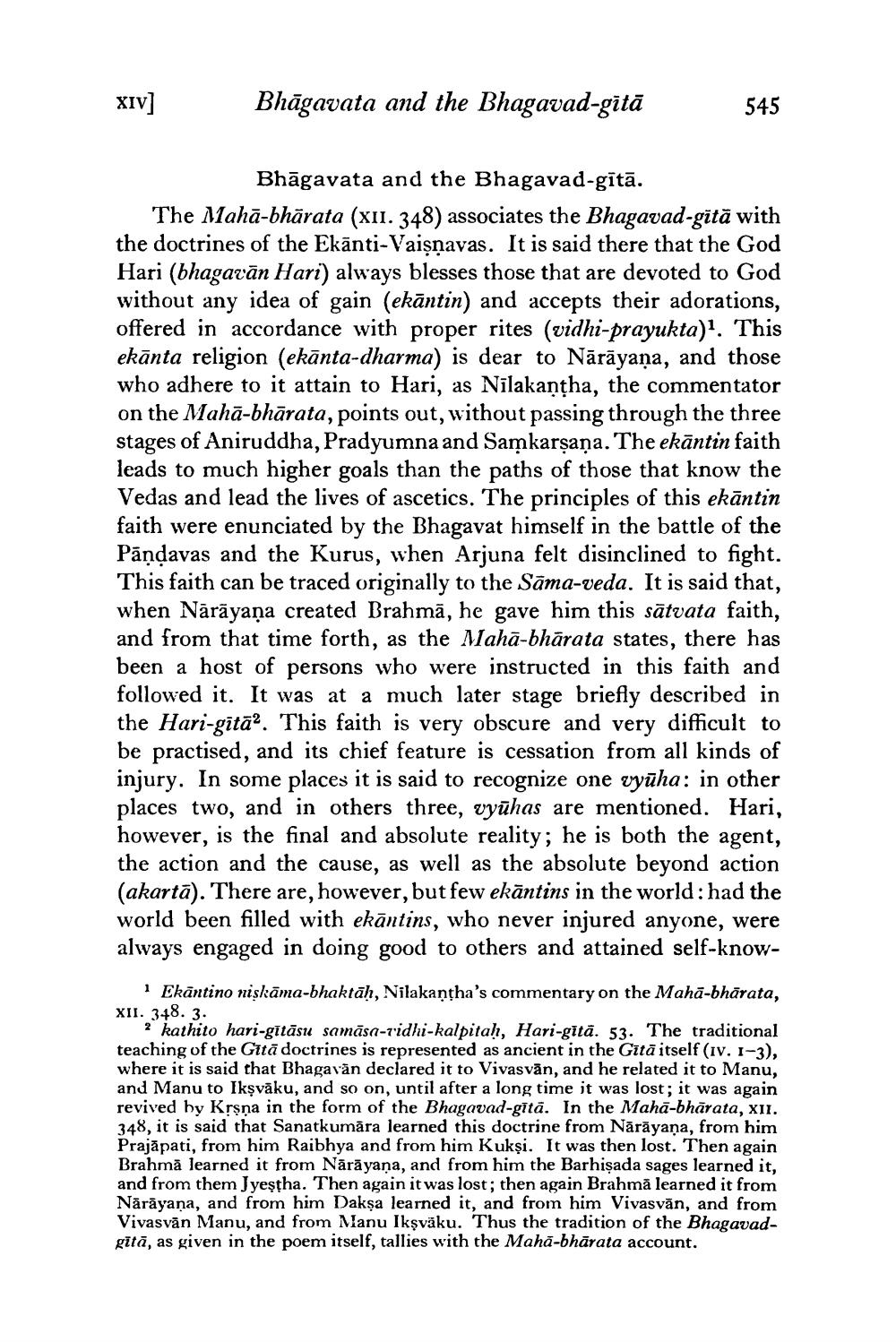________________
XIV]
Bhagavata and the Bhagavad-gitā
545
Bhāgavata and the Bhagavad-gītā.
The Maha-bharata (XII. 348) associates the Bhagavad-gita with the doctrines of the Ekanti-Vaisnavas. It is said there that the God Hari (bhagavan Hari) always blesses those that are devoted to God without any idea of gain (ekāntin) and accepts their adorations, offered in accordance with proper rites (vidhi-prayukta)1. This ekānta religion (ekānta-dharma) is dear to Nārāyaṇa, and those who adhere to it attain to Hari, as Nilakantha, the commentator on the Mahā-bhārata, points out, without passing through the three stages of Aniruddha, Pradyumna and Samkarṣaṇa. The ekantin faith leads to much higher goals than the paths of those that know the Vedas and lead the lives of ascetics. The principles of this ekantin faith were enunciated by the Bhagavat himself in the battle of the Pandavas and the Kurus, when Arjuna felt disinclined to fight. This faith can be traced originally to the Sama-veda. It is said that, when Nārāyaṇa created Brahma, he gave him this sātvata faith, and from that time forth, as the Maha-bharata states, there has been a host of persons who were instructed in this faith and followed it. It was at a much later stage briefly described in the Hari-gita2. This faith is very obscure and very difficult to be practised, and its chief feature is cessation from all kinds of injury. In some places it is said to recognize one vyūha: in other places two, and in others three, vyuhas are mentioned. Hari, however, is the final and absolute reality; he is both the agent, the action and the cause, as well as the absolute beyond action (akarta). There are, however, but few ekantins in the world: had the world been filled with ekantins, who never injured anyone, were always engaged in doing good to others and attained self-know
1 Ekantino niskāma-bhaktāḥ, Nilakantha's commentary on the Maha-bharata, XII. 348. 3.
2 kathito hari-gītāsu samāsa-vidhi-kalpitaḥ, Hari-gitā. 53. The traditional teaching of the Gita doctrines is represented as ancient in the Gītā itself (Iv. 1-3), where it is said that Bhagavan declared it to Vivasvān, and he related it to Manu, and Manu to Ikṣvāku, and so on, until after a long time it was lost; it was again revived by Kṛṣṇa in the form of the Bhagavad-gitā. In the Maha-bhārata, XII. 348, it is said that Sanatkumara learned this doctrine from Nārāyaṇa, from him Prajapati, from him Raibhya and from him Kukşi. It was then lost. Then again Brahma learned it from Nārāyaṇa, and from him the Barhiṣada sages learned it, and from them Jyeṣṭha. Then again it was lost; then again Brahma learned it from Nārāyaṇa, and from him Dakṣa learned it, and from him Vivasvän, and from Vivasvan Manu, and from Manu Ikṣvāku. Thus the tradition of the Bhagavadgītā, as given in the poem itself, tallies with the Maha-bhārata account.




